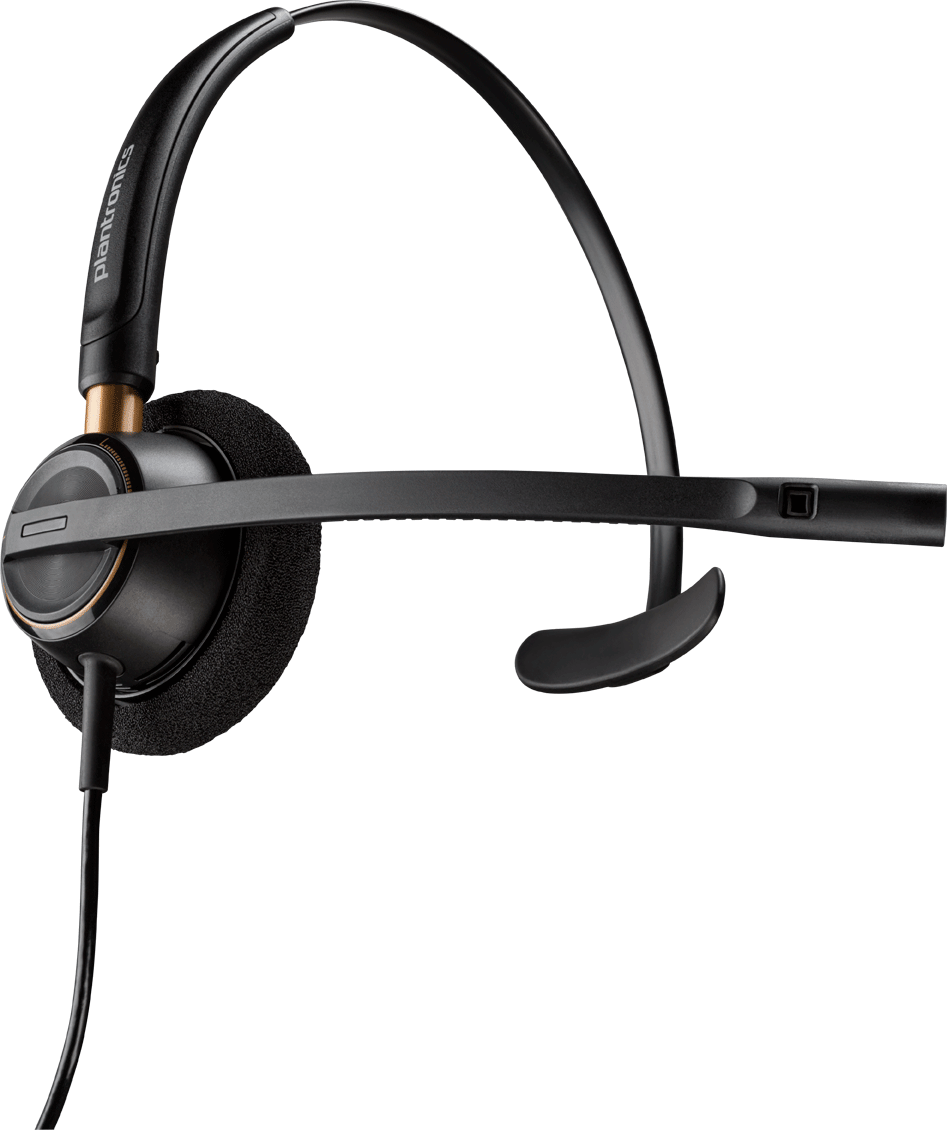All about headsets and what they mean
A Simple Guide to Headset Technology
As telecommunications technology keeps changing and spawning exciting new product lines in headsets, how do you keep up? Is an over-the-head or earbud design right for you? We have a quick solution. Just take a minute to scan the list of commonly used terms and trademarks below, and we can give you a jumpstart on determining which Plantronics headset solution best suits you!
2.4 GHz or 1.9ghz
A wireless frequency used for headsets or cordless phones to transmit signals. In general 1.9 GHz wireless headsets are less susceptible to interference and more commonly used today The CS 540 is a great example of this technology.
The more traditional wireless frequency. Many older cordless phones are 900 MHz.
·2.5 mm
2.5 millimeter plugs are standard, round plugs. These plugs either come standard or can be added to headsets, which should fit standard mobile and cordless phones and many corded telephones.
·3.5 mm
3.5 milimeter plugs are standard, round plugs often found on stereos and computers. They are larger than the 2.5 mm round plugs found on telephones.
Many Plantronics computer headsets come with two 3.5 mm plugs which connect into your sound card's microphone input (pink or red) and line output (black, blue, or green).
A– ACD
Automatic Call Distribution — A type of phone system used in professional call centers where incoming calls are routed to the different operators automatically.
Acoustic Coupler
A special seal on some headsets (notably the Plantronics M130) that allows better caller focus by blocking out unwanted sounds.Amplifier
Sounds from your telephone are generally too weak to drive the speakers in a headset - Amplifiers make sounds louder. The Amplifier is typically a small box that sits next to your phone and provides access to volume controls etc. This technology enables headsets to be used with corded phones and phone systems. Plantronics and Jabra make and manufacture a wide selection of corded, stand-alone amplifiers, such as the M12 M22, GN 8000 and A20. Amplifiers are also included as part of a headset system, such as the S12 The Headset Express Viking NC Pro brand of headsets are supplied with or without an amplifier..
(Compare with Digital)
In the context of wireless phones: Analog signals are generally not encrypted and are of limited bandwidth.
In the context of computer headsets: Analog Headsets offer connectivity to your sound card via 3.5mm jacks - in much the same way as headphones for a Walkman.
Used with the Plantronics and Jabra Wireless Headset Systems, this device allows you to answer the phone without returning to your desk to lift the receiver. The remote answering platform for the Plantronics Wireless Headset System can be purchased in our Wireless section.
B Behind-the-Neck / behind the head
A style of headset with a band that drapes around the nape of your neck. Found standard with the W740 Plantronics wireless headset.
·(Compare with Monaural)
A style of headset with speakers for both ears. Typically these offer the user a greater degree of caller focus.
See the Viking V92 for a great example of this headset.
A new protocol developed jointly by industry leaders in many fields, including Microsoft, Plantronics, Nokia, Ericsson, IBM, 3Com and Motorola. Bluetooth is still in its infancy, but the design allows for seamless, wireless, automatic connectivity between a large number of devices.
BT Abbreviation for Bluetooth.
Bluetooth version 2.0
Bluetooth 2.0 is backward-compatible with 1.1. The main improvement is the introduction of an Enhanced Data Rate for both data and voice packets. This additional speed is obtained by using a different radio transmission. Other advantages are three times faster transmission speed, lower power consumption, and simplification of multi-link capabilities.
Boom Microphone
A boom microphone is a microphone that is held in a fixed position from your mouth by an arm (or boom). It has significant benefits over a fixed, desktop microphone (such as the one in your telephone when it is used in ‘speakerphone mode’) because as you move your head around, the volume that the caller hears remains constant.
BroadBass speakers
(GN Netcom headsets)
Speakers with a wide dynamic range, particularly good at reproducing the lower or bass tones. This term is used to describe some headsets by GN Netcom, that have been specifically designed to minimize the ‘tinny’ sound that cheaper headsets can be plagued with.
Busy Light
The Busy Light is an easily visible light which indicates to others when you are on the line. Great for preventing interruptions and monitoring group phone activity. Works with or without a headset. Busy Lights can be purchased separately from our accessories page.
Call Clarity™
Plantronics Call Clarity™ system uses electronic signal processing to enhance transmission and reception through innovative noise reduction techniques that result in the clearest possible calls. With Call Clarity™, the headset wearer benefits from less phone line disturbance and background room noise. For both the wearer and the listener, the Call Clarity™ system ensures less confusion as to who is speaking.
(Compare with Intraural, Supraural)
A style of speaker that covers the entire ear, blocking out all sounds. This is typically not found on headsets (apart from specialist models) but is more common on headphones.
The cord that connects your base unit amplifier and your telephone.
(Contrast with Reversible)
Convertible headsets offer the choice of two or three wearing styles usually over-the-head for stability or over-the-ear for easy on/off convenience. These headsets can easily be "converted" from one style to the other in a few simple steps. Plantronics/Jabra/Viking all offer convertible headsets.
(1.9 GHz Wireless Frequency) DECT stands for "Digitally Enhanced Cordless Telephony",
1.9GHz DECT is a digital wireless technology which originated in Europe, but is now being adopted increasingly worldwide, for cordless telephones, wireless offices and even wireless telephone lines to the home. DECT has been designed and specified to be more compatible with other wireless technologies which can increase call clarity and security on headsets that use this standard.
This type of wireless technology used in certain Plantronics and Jabra headsets such as the CS540, W740 and GN 9450 series of wireless
(Compare with Analog)
In the context of wireless phones: Digital signals are less prone to interference and can be securely encrypted on the fly for greater security
In the context of computer headsets: Digital Headsets offer connectivity to your computer via the USB port. They require software (supplied) to function. The software can provide additional features (noise cancellation, frequency manipulations etc.)
(Contrast with Omni-Directional)
Usually applied to a microphone, when it is capable of receiving sounds from only one direction.
DC Adapter
The optional amplifier adapter provides power for your amplifier and eliminates the need for batteries. Just plug it in, and forget it! Amplifier adapters can be purchased separately from our accessories page.
·Date Code or Warranty code
The date code of your product designates its date of manufacture, and it can be used to establish your warranty period. The date code is generally listed with your product's model and part number, although this is not always the case. The date code can be located on the base of the unit, beneath the ear cushion, under the battery, or along the microphone boom
·DSP (Digital Signal Processing)
In Plantronics products, DSP refers to computer headsets that connect via the USB port rather than the computer's sound card.
E- Extension Cord
Our Extension Cord is a 7ft cord that gives you even more mobility while using your headset. Extension cords can be purchased separately from our accessories page.
·Earbud and In-the-ear style
Earbud style describes a small, discreet headset with a speaker that fits in the ear and the microphone positioned along the cord. The H132N office headset, as well as the MX100 and the M205 mobile headsets are some examples.
·Eartip
A foam or plastic tip that attaches to a headset and fits snugly inside of your ear.
(Plantronics Wireless)
Flex-Grip is a design style used to help an Over-the-Ear headset fit more comfortably and securely.
FlexFit™
(Plantronics Wireless)
FlexFit is a design style for an intraural headset that improves the stability of the microphone.
A subsidiary of GN Danavox, a Danish company. GN Netcom has over the last few years acquired many of the smaller brands of headset manufacturers, including Unex, ACS, Jabra and others. They produce a wired headset and a wireless line of headsets. Both are considered to be of very high quality. They are now known as exclusively as Jabra.
Gaming Headsets
Gaming headsets allow you to connect to the computer with a wire or wireless. They generally have larger ear wells then regular telephone headsets to block out back ground noise and let the gamer hear what's going on during the game. The mic has to be positive for fast verbal commands. Gaming headsets can use a 3.5 mil connection, usb or bluetooth to connect to your computer. Plantronics and Logitec both make great headsets in a wide variety of prices.
A headset is a device that connects to a phone, wither and office phone or cell phone or computer. There are a number of manufactures of telephone headsets. At Headset Express we carry a full range of products to meet all your needs.
-
Hand Receiver (Port)
The hand receiver is the portion of the telephone that you hold in your hand when talking. It is generally attached to the phone with a curly cord. The hand receiver plugs into the phone's hand receiver port (usually a square, modular plug).
·Headset (Port)
Some, but not all, phones have a headset port. This headset port may be a round, 2.5 mm plug, or a square modular RJ9 plug. However, most Plantronics amplifiers are designed to plug into the telephone's hand receiver port rather than the headset port.
Inline Volume Control
This type of volume control is built into the headset cord so you can change the volume of your headset in a natural and efficient manner.
In-the-Ear
A style of headset that uses an Intraural speaker. Typical examples are the ear bud style of headphones.
(Compare with Supraural, Circumaural)
A type of speaker that sits gently in the ear canal.
The Handset Lifter is a simple device that lifts your telephone receiver from its cradle and holds the line open while you talk. Perfect for reducing desktop clutter.
·Link Dropping
Link dropping means that the signal between the headset and the telephone periodically disconnects. If you experience link dropping, we recommend that you establish a new signal between the headset and the telephone by repairing or resubscribing your headset.
(Compare with Binaural)
A headset with a single speaker.
·Modular
Modular means square and generally refers to modular, RJ9 or RJ 45 plugs. Most Plantronics amplifiers use modular ports.
Noise-canceling refers to a microphone design that greatly reduces the transmission of background noise, enhancing headset sound quality. Noise-canceling headsets are especially effective for offices with employees in close proximity to one another. In mobile applications, noise-canceling microphones reduce background noise in cars, airports or on the street.This inexpensive option can greatly enhance the sound quality of your headset. See our V91 NC Pro headset as an example.
(Contrast with Directional)
Usually applied to a microphone, when it is capable of receiving sounds equally from any direction.
·Over-the-ear
Over-the-ear is used to describe Plantronics headsets that have over-the-ear earloops or other devices to hold headsets in place. TriStar®, Mirage® and the M130 are some examples.
·Over-the-head binaural
When it's important to help filter or screen out background sound, you should consider over-the-head binaural headsets, such as the Supra® (H61/H61N) headset and Encore® (H101/H101N) headset. This style provides sound transmission to both ears.
·Over-the-head monaural
Plantronics monaural headsets, on the other hand, deliver sound to one ear. Unless it says otherwise, Plantronics headsets are monaural.
The most common style of headset - with a headband that goes up and over your head. Typically available in single hearing “Monaural” and Double Hearing Binaural styles. Examples
PerSono™
PerSono is a software suite designed to enhance communications over VoIP softphones.
A headset manufacturer. They were one of the first to mass produce headsets including the one used by Neil Armstrong when he walked on the Moon.
A range of headsets from Plantronics designed to work with specific models of phones that have a built-in amplifier. Typically Meridian and Norstar Cisco and Polycom systems use this type of headset. See our direct plug in section
·Pairing
Pairing refers to establishing a wireless connection between a headset and a phone. It is often used to describe the initial set up between a Bluetooth headset and phone.
·Pairing Mode
Pairing mode is required to make the initial connection between a Plantronics Bluetooth headset and a Bluetooth device. When a Plantronics headset is in pairing mode, it will flash either blue/red or green/red for several minutes. During this time, it is possible to pair the headset to a Bluetooth device.
·Passkey
Passkey refers to a password needed to connect a Plantronics Bluetooth headset to a Bluetooth device. For most Plantronics products, this passkey is 0000.
·PerSono Software
Persono software is a free enhancement available for download from the Plantronics website. Several versions are available:
- < >
Software enhancement for use with DSP headsets
-
Provides tone control of headset audio
- < >
Software enhancement for use with DA60
-
Provides tone control of headset audio
-
Gives administrator option to disable headset mute and volume controls
Quick Adjust™
Quick Adjust refers to a telescopic microphone boom that lets you place the microphone in the optimal position for speech recognition and clarity of sound in your conversations.
·Quick Disconnect™
On most commercial grade headsets, the Quick Disconnect™ (QD) Connector is at the end of the headset cable that lets you disconnect your headset from an active call when you need to grab a fax or file, then easily reconnect. With the QD, there's no need to put the call on hold or remove your headset.
Used with Plantronics or Jabra Wireless Headset Systems, this device allows you to answer the phone without returning to your desk to lift the receiver.
(Contrast with Convertible)
A reversible headset can be worn with the speaker on either the left or right ear. The headset is designed to be easily adjustable to suit your preference.
·Radiolink
An active radiolink means that your headset currently has a live connection with your mobile or VoIP phone. An inactive link means that your headset is not in use.
·Receive
Your receive volume refers to the volume of what you hear. Increasing your receive volume will make the caller sound louder for you. It will not affect the way that your voice sounds to the caller.
·Resubscribe
To resubscribe is to reestablish the signal between a wireless headset and its amplifier. If the headset uses Bluetooth technology, this process is called "pairing."
A German company known best for its microphones, headphones, and telephone headsets.
A sound card converts the digital signal your computer produces into a signal that can be played through speakers or headphones.
Sound Enhancement System™ (SES)
(Plantronics)
The Plantronics Sound Enhancement System lets you highlight bass or treble sounds for a fuller, richer tone. It’s used on the Plantronics Encore line of headsets.
Soundguard™
Plantronics SoundGuard Plus™ technology, ensures that loud tones are quickly reduced and that any transient ‘pops’ are instantly capped. Most importantly, SoundGuard Plus™ ensures that the normal, human voice remains natural and unchanged, delivering face-to-face clarity of communication to the call center environment.
Standby-Time
(Contrast with Talk-Time)
Standby is a mode of operation on a wireless (or cellular) phone that allows it to conserve power while not in use. ‘Stand By Time’ is usually the amount of time that headset system will need between charges – even if no calls are made or received.
(Compare with Circumaural, Intraural)
A type of speaker that rests on the outside of the ear.
·Stereo
Stereo sound refers to sound that sends different signals to the left and right sides of the headsets, as opposed to mono sound, which sends just one signal. Stereo headsets are headsets that support stereo sound.
(Contrast with Standby-Time)
The number of hours you can talk on your headset before it must be recharged.
Three-Point Fit™
(Plantronics TriStar Headset)
This Plantronics technology provides four sizes of user-selectable earbuds and an adjustable receiver arm, so the headset can be customized to your preference. The headset is in contact with your ear in three places, each can be adjusted to match the uniqueness of your ear.
Our training adapter allows two headsets to connect to a single phone so supervisors can listen in with trainees. Ideal for getting new recruits up to speed as quickly as possible. Training adapters can be purchased separately from our accessories page.
Tru-Comfort™
A combination of design and materials that have been developed to allow the ear to breath during prolonged use, and to eliminate issues arising from long term pressure or contact on the outer ear.
Allows you to use a headset with your CAD COM, Key and other two-prong phone systems. Two prong adapters can be purchased separately from our accessories page.
·Transmit
Transmit volume refers to the volume of your voice and your headset's microphone. If you increase your transmit volume, your voice will sound louder to the caller. It will not affect the way that the caller's voice sounds for you.
·USB
USB stands for "Universal Serial Bus", and refers to a common port on computers. Some mobile phones also use USB or "mini-usb" connections to transfer data.
Voice Tube
A voice tube carries sound from your mouth to a microphone that is housed in the ear cup of a headset. This design strategy produces headsets that can be manufactured at a significantly reduced cost – a saving that is reflected in the cost to the end-user. The downside is that the microphone can not make use of Noise Canceling technologies, and is therefore less suitable for noisy environments. Voice tubes are removable and can be replaced.
·VoIP
VoIP stands for "Voice-over internet protocol" and refers to sending voice signals and phone calls over the internet.
·Y-Training Cable
The Y training cable allows you to connect two headsets with QD (Quick Disconnect) connections to one phone. It also includes a mute switch which allows you to mute either headset. This will allow two people to listen to the same call for training purposes
Now that you've mastered our basic course in headset technology, why not instantly see how it can make your life easier and more productive, whether it's in the office, at home, or in the car? Click on our product finder and you're sure to discover the perfect Plantronics headset, designed with your needs in mind.

 Follow us
Follow us
 Phone Finder
Phone Finder  Take A Look!
Take A Look! Check These Out!
Check These Out!
 Shopping Cart
Shopping Cart Bestsellers
Bestsellers








